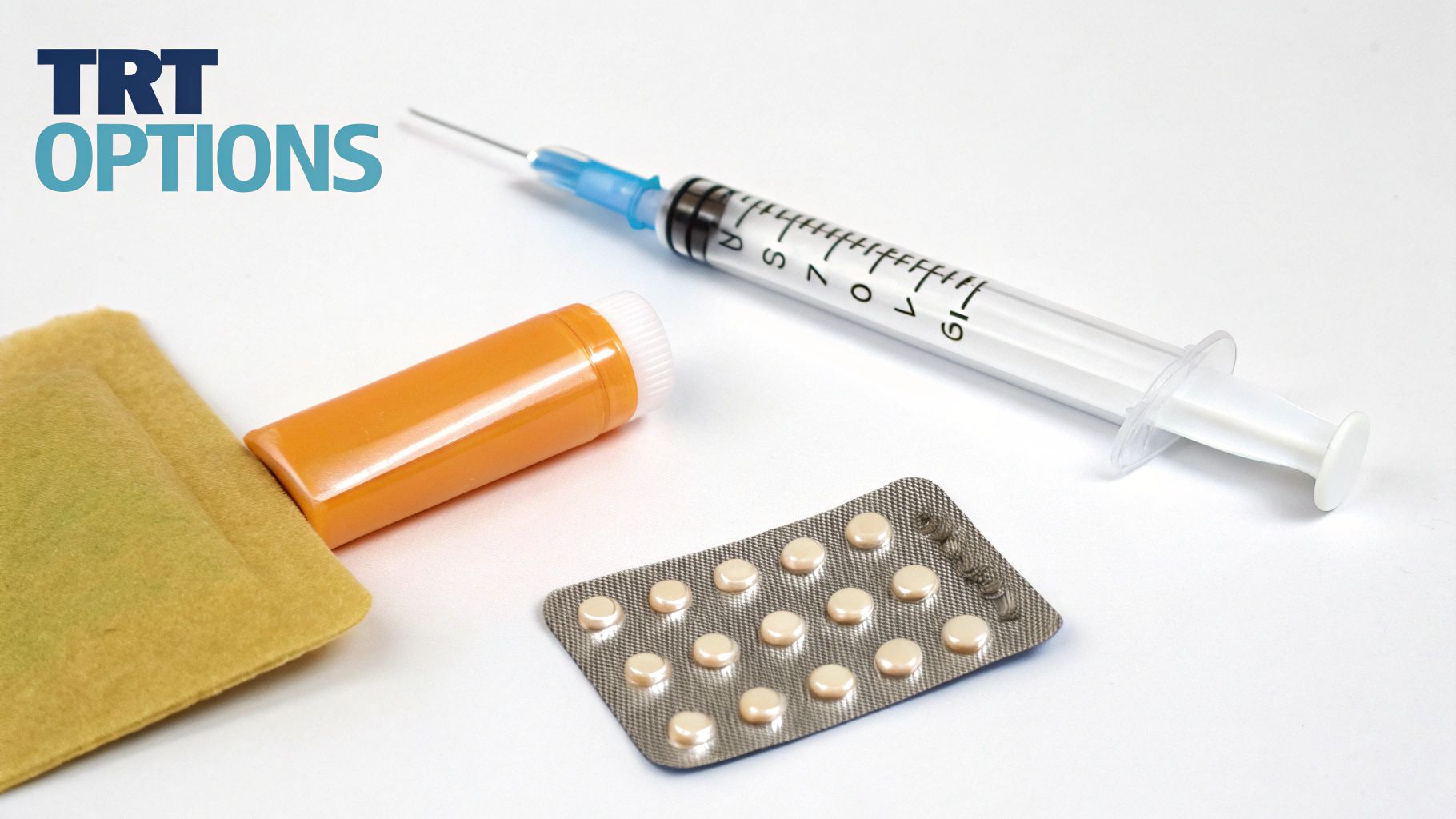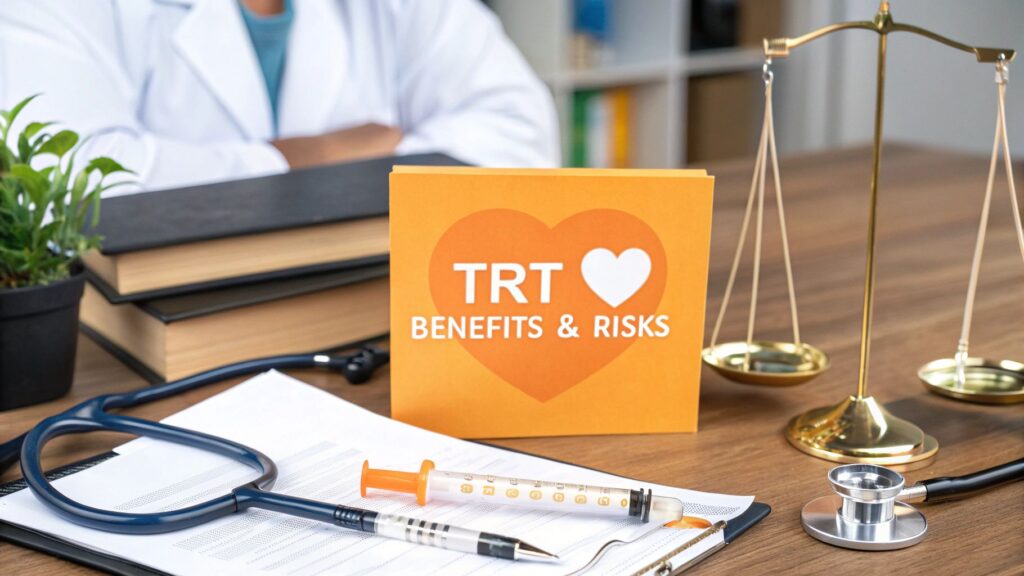Testosterone Replacement Therapy (TRT) is a serious medical treatment that can bring back energy, muscle mass, and libido for men with a diagnosed deficiency. But it’s not a decision to take lightly. You have to weigh those game-changing improvements against potential risks like skin issues, sleep apnea, or changes in your blood cell counts—all of which demand close medical supervision.
Getting a clear, balanced picture of both the benefits and the risks is the absolute first step toward making an informed choice about your health.
What Is Testosterone Replacement Therapy

Think of testosterone as the master switch for male vitality. It’s the hormone that drives everything from your energy and mood to your muscle strength and sex drive. When your body isn't producing enough—a condition known as hypogonadism—the effects can ripple through your entire life, leaving you feeling like a faded version of yourself.
This is exactly where Testosterone Replacement Therapy comes in. TRT is not some magic anti-aging potion or a shortcut to a pro-athlete physique. It's a precise medical therapy with one clear goal: to bring your testosterone levels back into a healthy, optimal range. The treatment works by supplementing your body's own supply, essentially "refilling the tank" so your systems can fire on all cylinders again.
The Core Purpose of TRT
At its heart, TRT is about treating a confirmed medical deficiency. A diagnosis isn't based on just feeling "off"; it requires solid evidence from blood tests that measure your hormone levels, combined with a thorough review of your symptoms. Starting therapy without this clinical proof is a bad idea.
Once a deficiency is confirmed, the treatment is carefully tailored by a healthcare provider who figures out the right dosage and delivery method for your specific needs.
Some of the key symptoms TRT is designed to fix include:
- Persistent fatigue that sleep just can't seem to touch.
- A noticeable drop in sex drive and performance.
- Difficulty concentrating, often described as "brain fog."
- Losing muscle while gaining body fat, especially around your middle.
- Mood swings, irritability, or feelings of depression.
The whole point of TRT is to improve your quality of life by tackling the root cause of these issues—low testosterone. It’s about helping you feel strong, sharp, and energized again.
Setting Realistic Expectations
It’s crucial to be clear on what TRT is and what it isn't. It is a medical treatment for a diagnosed condition, not a casual lifestyle tweak. While the benefits can be life-changing for the right person, therapy also demands a long-term commitment and ongoing medical oversight to manage any potential side effects.
To help you get a clear-eyed view of what's involved, let's break down the pros and cons side-by-side.
TRT at a Glance Key Benefits vs Potential Risks
This table provides a quick, balanced overview of the potential positive outcomes and negative side effects associated with Testosterone Replacement Therapy, helping you quickly grasp the key considerations.
| Potential Benefits | Potential Risks |
|---|---|
| Increased energy and reduced fatigue | Acne or oily skin |
| Improved libido and sexual function | Worsening of sleep apnea |
| Enhanced mood and cognitive clarity | Increased red blood cell count (erythrocytosis) |
| Increased muscle mass and strength | Potential for testicular shrinkage and reduced sperm count |
| Decreased body fat, especially visceral fat | Fluid retention and swelling |
| Improved bone density | Possible stimulation of prostate growth |
This side-by-side comparison makes it clear that while the upsides are significant, they come with responsibilities. This guide is designed to walk you through the entire landscape of TRT, from the science-backed benefits you can expect to an honest discussion of the risks and the importance of professional monitoring.
By building this foundational knowledge, you'll be empowered to have a much more meaningful conversation with your doctor and decide if TRT is the right path for you.
The Science-Backed Benefits of TRT

When testosterone is brought back into a healthy range with medically supervised TRT, the results are far more than just a better number on a lab report. These changes lead to real, tangible improvements you can feel every day, dramatically boosting your quality of life. The therapy gets to the root cause of those debilitating symptoms, letting your body function the way it was meant to.
Think of it like getting the power turned back on in a house that’s been running on low voltage. When the power is down, the lights are dim, and nothing works quite right. Restore it, and suddenly everything brightens up and runs at peak efficiency. In the same way, normalizing your testosterone can trigger a cascade of positive physical, mental, and sexual health benefits.
Boosting Physical Performance and Body Composition
One of the most talked-about benefits is the incredible impact TRT has on physical health. Testosterone is the master architect for building and keeping lean muscle. As levels drop, men often find it’s a constant uphill battle to build muscle—and frustratingly easy to lose it—no matter how hard they work out. TRT can completely turn that around.
Properly managed therapy jump-starts protein synthesis, which is the process your body uses to repair and grow muscle fibers after exercise. This translates to real, noticeable gains in both muscle size and raw strength.
But it’s not just about muscle. TRT also has a major effect on body composition by targeting stubborn fat, especially the visceral fat that collects around your midsection. By improving how your metabolism functions, your body gets much better at burning fat for fuel.
The key physical changes include:
- Increased Lean Muscle Mass: Men often see a measurable jump in muscle, which leads to a stronger physique and a higher resting metabolism.
- Reduced Body Fat: Therapy can help lower your overall body fat percentage, giving you a leaner, more defined look.
- Improved Bone Density: Testosterone is critical for keeping bones strong. Bringing levels back up can slow bone loss and lower the long-term risk of osteoporosis and fractures.
Clinical studies consistently show that TRT effectively treats hypogonadism by improving symptoms like fatigue, anemia, and reduced muscle mass. Furthermore, controlled trials report that TRT can reduce body fat, enhance cognitive function, and contribute to an enhanced quality of life. You can explore a deeper analysis of the TRT market and its therapeutic effects on Technavio.
Enhancing Mental Clarity and Emotional Well-Being
The effects of low testosterone run deep, often clouding your mental and emotional state. Many men with a deficiency describe a constant "brain fog" that makes it tough to concentrate, stay motivated, or just feel sharp. Getting your hormones back in balance can feel like lifting a heavy curtain off your mind.
This mental boost is often one of the first things men notice. Tasks that felt overwhelming suddenly seem manageable again, and focus returns with a new sense of clarity. The emotional benefits are just as powerful. Low T is tightly linked to irritability, mood swings, and even feelings of depression. By stabilizing hormone levels, TRT helps promote a more even-keeled, positive mood.
For anyone considering this therapy, exploring the comprehensive benefits of TRT can paint a clearer picture of what to expect. This isn’t just about feeling happier; it’s about getting back your drive and emotional resilience.
Revitalizing Libido and Sexual Function
Perhaps the most well-known benefit of TRT is its power to bring back libido and improve sexual function. Testosterone is the main hormone driving a man's sex drive, and when it plummets, desire often goes with it. This can put a serious strain on relationships and self-confidence.
By restoring levels to an optimal range, TRT directly targets the physiological cause of a low libido. Men frequently report a significant return of sexual interest and desire, often within just a few weeks of starting. This usually comes hand-in-hand with better erectile quality and overall sexual satisfaction.
The therapy essentially reawakens the pathways responsible for sexual arousal and performance, helping you reclaim a healthy and fulfilling sex life. For many men, this revitalization is a cornerstone benefit that makes them feel like themselves again.
Navigating the Potential Risks and Side Effects
Just like any powerful medical tool, testosterone replacement therapy has potential downsides that you need to respect and understand. An honest conversation has to include a clear-eyed look at the possible side effects. This isn't about scaring you off; it's about arming you with the knowledge to make safe, informed decisions alongside your doctor.
Think of it like getting a guide for a river trip. A good guide doesn't just point to the final destination—they show you where the hidden rocks and rapids are. Knowing the potential hazards ahead of time lets you chart a much safer course. A qualified physician is that guide, helping you avoid trouble through careful screening, personalized dosing, and consistent monitoring.
Cardiovascular Health Considerations
One of the hottest topics around TRT is its effect on the heart. For years, conflicting studies created a cloud of confusion, but modern research is finally painting a clearer picture. While some older, flawed studies hinted at a link to heart attacks or strokes, many large-scale, recent analyses have found no direct cause-and-effect relationship when the therapy is managed correctly.
That said, TRT can influence factors related to heart health, which is exactly why medical supervision is non-negotiable.
A key area of focus is polycythemia, which is just a technical term for an increase in red blood cell concentration. Testosterone signals the bone marrow to ramp up red blood cell production. While this is great for fixing anemia in men with low T, too much of an increase can make the blood thicker and more viscous.
Thicker blood can potentially raise the risk of clotting events like a deep vein thrombosis (DVT) or a pulmonary embolism. This is precisely why your doctor will keep a close eye on your hematocrit levels through routine blood work, tweaking your dose as needed to keep you well within a safe range.
This proactive monitoring is the safety net that lets you enjoy the benefits of TRT while keeping this specific risk in check.
Prostate Health and Monitoring
The connection between testosterone and the prostate has also been a major point of debate. The old, outdated belief was that TRT could actually cause prostate cancer. Today, the medical consensus has done a complete 180. High-quality evidence now shows that TRT does not increase the risk of developing prostate cancer in men who don't already have it.
However, testosterone can act like fertilizer for existing prostate tissue. This means if you have an undiagnosed, pre-existing cancer, TRT could potentially encourage it to grow. This is why thorough screening before you even think about starting therapy is absolutely mandatory. Your doctor will perform a digital rectal exam (DRE) and order a prostate-specific antigen (PSA) blood test.
For men who already have benign prostatic hyperplasia (BPH), or an enlarged prostate, TRT can sometimes make urinary symptoms a bit worse. This is another critical reason to maintain an open dialogue with your doctor, so you can manage any changes you notice.
Other Potential Side Effects
Beyond the heart and prostate, there are a few other potential side effects that a well-managed treatment plan is designed to anticipate and address. Not everyone gets them, but it’s smart to be aware of what could happen.
- Skin Changes: Testosterone can kick sebum production into high gear—that’s the natural oil on your skin. For some guys, this can lead to oily skin or acne, kind of like a flashback to puberty.
- Sleep Apnea: The evidence here isn't crystal clear, but some studies suggest TRT might worsen existing obstructive sleep apnea (OSA). If you have a history of snoring or rough nights, your doctor will want to monitor this closely.
- Fluid Retention: In some cases, TRT can make the body hang on to more fluid, which can lead to swelling (edema) in the ankles or feet.
- Testicular Atrophy: When your body gets testosterone from an outside source, it tells your own production line—the testes—to slow down. Over time, this can cause them to shrink. While this is often just a cosmetic issue, it’s tied to a much bigger one: infertility.
Because TRT significantly dials down sperm production, it is generally not a good option for men who are actively trying to have children. If you want to dive deeper, our detailed guide covers the full spectrum of potential testosterone therapy side effects and how a good doctor manages them.
Ultimately, navigating the world of TRT comes down to the partnership between you and your healthcare provider. With diligent screening, a personalized treatment plan, and regular check-ins, these potential risks can be effectively managed, ensuring your path to better health is both safe and successful.
Determining If You Are a Candidate for TRT
So, who is testosterone replacement therapy actually for? There’s a common myth that TRT is just a lifestyle choice—a quick fix for the natural slowdown that comes with getting older. The reality is much different. TRT is a specific medical treatment reserved for men with a confirmed diagnosis of hypogonadism, a condition where the body simply isn't producing enough testosterone on its own.
Figuring out if you’re a candidate isn't based on a hunch or a single bad day. It's a methodical process that separates a genuine medical need from a desire for a performance boost. Think of your physician as a detective, gathering clues from your physical symptoms and hard lab data to build a complete picture of your hormonal health. This ensures the significant decision to start TRT is made for all the right reasons.
The Diagnostic Process: Symptoms and Blood Work
The journey always starts with you. It’s the persistent, unexplained symptoms that typically prompt a man to finally talk to his doctor. We're not talking about minor inconveniences here, but chronic issues that slowly chip away at your quality of life.
Common symptoms that absolutely warrant investigation include:
- Chronic Fatigue: A deep, lasting exhaustion that sleep just doesn't seem to fix.
- Low Libido: A significant and sustained drop in your desire for sex.
- Erectile Dysfunction: Consistent trouble achieving or maintaining an erection.
- Brain Fog: A frustrating inability to concentrate, remember things, or feel mentally sharp.
- Mood Disturbances: Noticing you're more irritable, having mood swings, or even feeling symptoms of depression.
- Loss of Muscle Mass: Finding it much harder to build or even maintain muscle, despite hitting the gym regularly.
If this list sounds uncomfortably familiar, your doctor’s next move is non-negotiable: a blood test. To confirm hypogonadism, at least two separate blood tests must show a low total testosterone level. These are usually taken in the morning, which is when your T levels are naturally at their peak.
A diagnosis is a two-part puzzle. It requires both the presence of clinical symptoms and biochemical evidence from blood tests. Without both pieces, a reputable physician will not prescribe TRT.
This careful approach is becoming more common as a growing number of men seek treatment. Globally, there are around 11 million testosterone therapy prescriptions, and the most significant increase—about 60%—is in men aged 35 to 44. This isn't just a trend; it shows a shift where younger men are proactively addressing their health, moving past the old view of TRT as something only for much older individuals. You can explore more insights into this growing demand as a younger generation fuels the market.
Understanding Who Should Avoid TRT
Just as important as identifying good candidates is knowing who should steer clear of TRT. Certain pre-existing health conditions, known as contraindications, make the therapy unsafe. These are hard stops in the decision-making process because the risks would far outweigh any potential benefits.
This decision tree infographic breaks down the key risk factors your doctor will screen for before ever recommending therapy.

As the visual shows, a history of prostate or breast cancer, or a high risk of blood clots, are primary reasons to avoid TRT altogether.
Your doctor will conduct a thorough screening for these issues. The major contraindications include:
- Prostate or Breast Cancer: Since testosterone can fuel the growth of these specific cancers, a current or past diagnosis is an absolute deal-breaker.
- Elevated PSA Levels: A high Prostate-Specific Antigen (PSA) level doesn't automatically mean you have cancer, but it needs to be investigated thoroughly before TRT can even be considered.
- Severe Heart Failure: For men with advanced congestive heart failure (CHF), TRT can worsen fluid retention, creating a very dangerous situation.
- Untreated Obstructive Sleep Apnea: If you have severe, untreated sleep apnea, testosterone therapy can make it worse.
- Desire for Future Fertility: TRT shuts down your body's natural sperm production. For men who are actively trying to have children, it's not a suitable option.
Ultimately, figuring out if you're a candidate for TRT requires a real partnership with a knowledgeable healthcare provider. It’s a process of honestly evaluating your symptoms, undergoing the proper testing, and screening for any risks so you can make a safe and fully informed decision about your health.
Comparing TRT Administration Methods

Once you and your doctor decide that TRT is the right path, the next question is always the same: how are we going to do this? The way testosterone is delivered is a huge part of your treatment plan, shaping everything from your daily routine to how stable your hormone levels will feel. This isn't a one-size-fits-all deal; each option has its own trade-offs when it comes to convenience, cost, and overall effectiveness.
Think of it like choosing a vehicle for a long road trip. You could pick a sports car that's fast but needs frequent fill-ups, or a steady SUV that runs for miles on a single tank. Both get you to the destination, but the experience along the way is completely different. The same is true for TRT—the best choice comes down to your lifestyle, your personal preferences, and what your body needs.
Injections: The Gold Standard for Many
Testosterone injections are easily one of the most common and cost-effective ways to administer TRT. The process involves injecting testosterone directly into a muscle, usually the glute or thigh, which lets the hormone release slowly into your bloodstream over time.
This method is incredibly effective at raising testosterone levels and is often considered the gold standard for getting stable, predictable results. However, it does require a commitment to a regular injection schedule, and for some guys, that's a significant drawback.
- Frequency: Usually given every 7 to 14 days, though some newer protocols use smaller, more frequent injections to maintain smoother levels.
- Pros: Highly effective, allows for very precise and customizable dosing, and is generally the most affordable option available.
- Cons: You have to be comfortable with needles. It can also create hormonal "peaks and troughs," which might lead to fluctuations in mood and energy for some people.
Even within injections, there are different types to consider. To get a better handle on all the details, check out our deep dive into testosterone oral vs injection methods.
Topical Gels and Patches: The Daily Approach
For men who’d rather skip the needles altogether, topical options like gels and patches offer a convenient daily alternative. These methods deliver testosterone right through the skin, providing a steady, continuous absorption that does a better job of mimicking the body's natural production rhythm than weekly shots.
Gels are typically applied once a day to the shoulders, upper arms, or abdomen. Patches are stuck to the skin and worn for 24 hours. While they're super convenient, you have to be careful to avoid transferring the testosterone to others—especially women and children—through skin-to-skin contact.
The biggest advantage of daily topicals is their ability to maintain very stable hormone levels, avoiding the highs and lows that can sometimes come with injections. This consistency often translates to a more even mood and energy level day in and day out.
But they aren't perfect. Skin irritation can be a problem for some, and for others, the daily ritual can start to feel like a bit of a chore.
Subdermal Pellets: The "Set-It-and-Forget-It" Option
Testosterone pellets are the long-game solution. These are tiny, rice-sized pellets that a doctor surgically implants under the skin, usually in the hip or buttock area, during a quick in-office procedure. Once they're in, they slowly release testosterone over a period of three to six months.
This method is perfect for men who value convenience above all else and would rather not think about their therapy on a daily or weekly basis. After the brief procedure, there are no daily gels or weekly shots to remember.
Of course, that convenience comes with a higher upfront cost, and the procedure is more invasive than other methods. Making adjustments to your dose also requires a whole new insertion procedure, so it’s less flexible if your levels need a little tweaking along the way.
To give you a clearer picture, here’s a side-by-side look at how these common delivery methods stack up.
Comparison of TRT Delivery Methods
| Method | Frequency | Pros | Cons |
|---|---|---|---|
| Injections | Every 1-2 weeks | Highly effective, cost-efficient, customizable dosing. | Requires needles, can cause hormonal peaks and valleys. |
| Topical Gels/Patches | Daily | Stable hormone levels, mimics natural rhythm, non-invasive. | Risk of skin-to-skin transfer, potential for skin irritation. |
| Subdermal Pellets | Every 3-6 months | Extremely convenient, no daily/weekly routine to follow. | Higher upfront cost, invasive procedure, less flexible dosing. |
Each method has clear benefits and drawbacks, making the "best" choice a truly personal one. A guy who travels constantly might find pellets to be a game-changer, while someone on a tight budget might stick with the tried-and-true injection protocol.
This variety in delivery systems is a big reason the TRT market continues to expand. The global TRT market was valued at around USD 2.07 billion and is projected to climb to USD 2.97 billion by 2032. This growth isn't just about an aging population; it's also driven by these innovations that make therapy more accessible and patient-friendly than ever before.
Got Questions About TRT? Let's Talk Specifics
Even after weighing the benefits and risks, it’s the day-to-day stuff that really matters. What will this feel like? How long does it take to work? These are the practical questions that shape your decision. This final section cuts through the noise and gives you straight answers to the most common questions people have.
We’ve covered the "what" and the "why." Now it's time to tackle the "what ifs" and "how longs" so you have the full picture before moving forward.
How Long Until I Start Feeling the Benefits?
This is usually the first question on everyone's mind, and the answer is that TRT is a journey, not an overnight fix. The benefits don't all show up at once; they tend to roll in over weeks and months.
The first changes are often mental and emotional. Many guys report a noticeable shift within the first 3 to 6 weeks—a better mood, sharper focus, and the return of their sex drive. This renewed energy and motivation is often the first sign that the therapy is kicking in.
Physical changes take a bit more patience. If you’re looking for improvements in body composition, like building more lean muscle and losing stubborn body fat, you’ll typically start seeing those results after about 3 to 6 months of consistent therapy.
Does TRT Shut Down My Natural Testosterone Production?
Yes, and this is a critical point to understand. When your body starts getting testosterone from an outside source, it signals the brain to stop making its own. This feedback loop effectively puts your natural testosterone production on pause.
This is exactly why TRT is such a significant commitment. It’s not something you can just try for a few weeks and stop without consequences. If you halt the therapy, your testosterone levels will fall back to their previous low, and the symptoms you wanted to fix will likely come right back.
For men concerned about fertility, this is a must-discuss topic with your doctor. In some cases, physicians can add medications like HCG (Human Chorionic Gonadotropin) to your protocol. HCG helps stimulate the testes to maintain their function and continue sperm production while on TRT.
Is TRT a Lifelong Commitment?
For most men with a confirmed diagnosis of chronic hypogonadism, the answer is yes. TRT is a long-term, and often lifelong, therapy. The underlying issue—your body's inability to produce enough testosterone on its own—doesn't get "cured" by the treatment. TRT is a management strategy.
Think of it like managing any other chronic condition, such as diabetes or high blood pressure. The medication works for as long as you take it. If you stop, your levels will drop, and the symptoms that brought you to the doctor in the first place will almost certainly return. It's a true partnership between you and your healthcare provider.
Can Women Use Testosterone Therapy Too?
While it’s mainly known as a male therapy, testosterone can be a game-changer for some women, though it's prescribed much less often. Testosterone isn't just a male hormone; women produce it in smaller amounts, and it’s crucial for their energy, mood, and sex drive.
It's most commonly considered for postmenopausal women who are struggling with issues like a persistent low libido, mental fog, or chronic fatigue that haven't improved with standard estrogen therapy. The biggest difference, of course, is the dose.
- Much Lower Doses: Women need only a fraction of the testosterone men do to bring their levels into a healthy range.
- Expert Oversight: Treatment for women absolutely must be managed by a healthcare provider with deep experience in female hormone therapy to avoid side effects.
This shows that while TRT is primarily a treatment for men, its principles can be adapted to help women restore their vitality under the right medical supervision.
At Elite Bioscience, we believe informed decisions are the foundation of good health. If you're ready to explore how personalized hormone therapy can help you reclaim your energy and vitality, we're here to guide you. Discover our secure, medically supervised TRT programs and take the first step toward a stronger, healthier you. Learn more and get started at https://elitebioscience.co.







